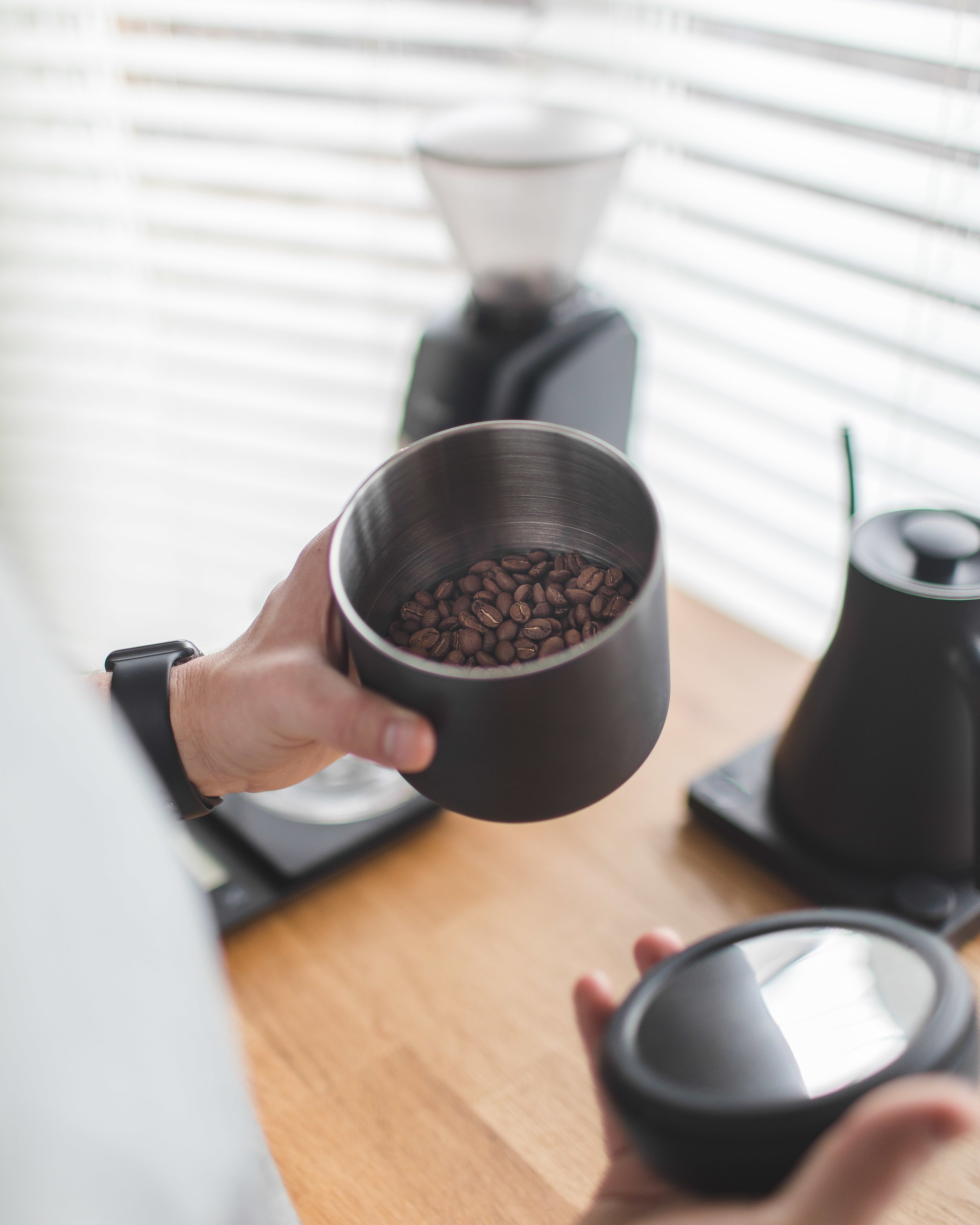Fellow Atmos
From the minute you buy a bag of freshly roasted coffee, the countdown is on.
A mortal death march expedited day by day as your coffee goes from fresh to stale in the blink of an eye. There’s a lot of variables that contribute to the freshness of your coffee beans, and truth be told the countdown from tasty to tasteless begins before you’ve even bought it. As soon as those precious beans were exposed to heat to be roasted, some sort of science happens and continues to happen every day post roast.
For every oxygen molecule that your coffee is exposed to and every UV ray that shines on it, your chances of brewing the perfect cup diminish.
So, what do you do?
How can you slow down the natural oxidation process to ensure that you can drink your entire bag of coffee before it goes stale?
Well some will suggest that you freeze it, others will tell you to put it an airtight container, but if your like most common coffee drinkers you’ll likely just leave it in the bag you bought it in.
I’ve only ever kept my coffee in the bags they come in, as most specialty coffee roasters sell their beans in bags equipped with a one way valve. That means once you’ve sealed the bag you can squeeze the remaining air out and it shouldn’t get back in. It’s worked fine enough for me, and I can usually drink a bag without it getting past the point of tasting stale. Sure, the flavour profile develops over the ~2 weeks it takes me to polish off a bag, but that’s to be expected and not always undesirable.
So when it comes to storing your coffee at room temperature (read about storing your coffee below zero here) are one way valves enough?
I’ve never been convinced, and people much smarter than me seem to share that hypothesis. A young Drew Cosgarea didn’t think so either, so in his junior year at Stanford College he dreamt up a vacuum sealed coffee canister to manufacture for a popular design credit. A few years later, Drew is now the Product Development Engineer of Fellow Products and his vision has been brought to life - Atmos was born.
What is Atmos?
The unique pattern on the inside of the lid is the ambiguous face of an ingenious vacuum
Fellow Atmos is a vacuum sealed coffee canister that just happens to be the first of it’s kind. It’s not the first vacuum sealed canister ever, but it is the first self contained one. There are a few vacuum canisters that require an external pump, but that’s where Atmos sets itself apart. At a quick glance you’d never guess there’s a vacuum mechanism anywhere in this thing, and even upon closer inspection it’s hard to believe the ingenuity of it. Concealed cleverly in the lid of Atmos, the vacuum functions as you twist the lid back and forth a few times.
Why a Vacuum?
I’m no scientist, but from what I understand there are compounds created in the roasting process that make your coffee smell and taste good. When those compounds are exposed to oxygen, some horny little O2 molecules infiltrate your coffee’s business and start gobbling up precious electrons. This process is called oxidation and this is how your coffee goes stale. The pressure of the oxygen directly contributes to the speed of that oxidation process (again, science), hence the vacuum.
What’s the Verdict?
Just like every other Fellow product, these canisters are downright gorgeous. Atmos comes in two styles - glass and stainless steel - 0.4L, 0.7L, and 1.2L versions of each. I opted for the stainless steel Atmos for two reasons.
First, that gorgeous matte black finish.
Second (and more importantly), the stainless version keeps my beans safe from light. UV rays play their own nasty role in oxidation, so I opted to keep my coffee in the dark. The glass Atmos are great if you’re not keeping your coffee in direct sunlight like I do, or they don’t even have to be used for coffee. You can store all kinds of dry goods in these sleek containers! The vacuum will help keep your dry goods fresh in the same way they do for coffee.
The vacuum sealing process is as ingenious as it is simple - place the lid on the container and twist back and forth. You’ll know you’ve gotten rid of all that savage air when the lock indicator on the lid drops to reveal a green ring. Once you’re locked and loaded, store that coffee wherever you’d like until you’re ready to drink it and it’ll be just as you left it.
When it’s time to drink, simply press the easy release button also found on the lid to relieve the pressure and unlock your canister. Make sure there’s no noise in the room when you do it though so you can experience the satisfying sound of the vacuum releasing. It’s basically the sound of your coffee breathing a sigh of thankful relief.
Green Washi Tape from Amazon helps to keep my coffees in order
I bought three Atmos right away (I have eight now) as I always have at least three bags of coffee on the go. If you go with the glass version, you can put the label of the coffee you’re drinking inside the container to keep track of what’s inside. In my case with the black Atmos, I picked up some green Washi Tape for a couple bucks off Amazon to label my three canisters and keep my coffees straight. I opt to turn the label to the back for the sake of an all-black-everything aesthetic, and you could even slap your tape on the bottom if you’d like.
I don’t have any empirical data to prove how long Atmos extends the life of my coffee for, but I can tell you that I feel much better about what I’m storing my beans in. Not only do they look great and feel amazing, the science seems to suggest they’re doing your coffee good as well. There’s literally blood, sweat, and tears put into getting freshly roasted coffee in a bag and on your counter, and you’ve likely paid hard earned money to get it there. The least you could do is make sure that once it gets on your bar it won’t go stale before you can drink it.



